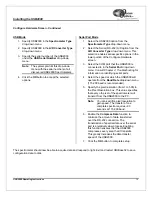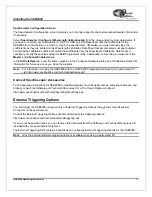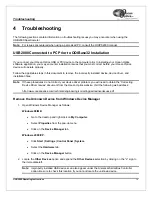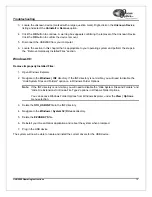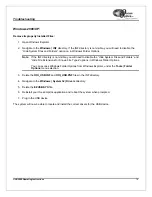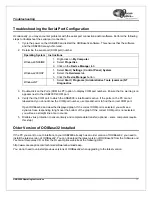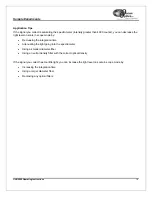
USB2000 Specifications
USB2000 Operating Instructions
6
USB2000 Component Table
Ocean Optics permanently secures all components in the USB2000 at the time of manufacture. Only Ocean
Optics Technicians can replace interchangeable components, where noted.
Item Name
Description
1 SMA
Connector
The
SMA Connector
secures the input fiber to the spectrometer. Light from the
input fiber enters the optical bench through this connector.
2 Slit*
The
Slit
is a dark piece of material containing a rectangular aperture, which is
mounted directly behind the SMA Connector. The size of the aperture regulates the
amount of light that enters the optical bench and controls spectral resolution.
You can also use the USB2000 without a
Slit
. In this configuration, the diameter of
the fiber connected to the USB2000 determines the size of the entrance aperture.
Only Ocean Optics technicians can change the
Slit
.
3 Filter*
The
Filter
is a device that restricts optical radiation to pre-determined wavelength
regions. Light passes through the
Filter
before entering the optical bench. Both
bandpass and longpass filters are available to restrict radiation to certain
wavelength regions.
Only Ocean Optics technicians can change the
Filter
.
4 Collimating
Mirror
The
Collimating Mirror
focuses light entering the optical bench towards the Grating
of the spectrometer.
Light enters the spectrometer, passes through the SMA Connector, Slit, and Filter,
and then reflects off the
Collimating Mirror
onto the Grating.
5 Grating*
The
Grating
diffracts light from the Collimating Mirror and directs the diffracted light
onto the Focusing Mirror.
Gratings
are available in different groove densities,
allowing you to specify wavelength coverage and resolution in the spectrometer.
Only Ocean Optics technicians can change the
Grating
.
6 Focusing
Mirror
The
Focusing Mirror
receives light reflected from the Grating and focuses the light
onto the CCD Detector or L2 Detector Collection Lens (depending on the
spectrometer configuration).
7
L2 Detector
Collection Lens*
The
L2 Detector Collection Lens
(optional) attaches to the CCD Detector. It
focuses light from a tall slit onto the shorter CCD Detector elements.
The
L2 Detector Collection Lens
should be used with large diameter slits or in
applications with low light levels. It also improves efficiency by reducing the effects
of stray light.
Only Ocean Optics technicians can add or remove the
L2 Detection Collection
Lens
.
8
CCD Detector
(UV or VIS)
The
CCD Detector
collects the light received from the Focusing Mirror or L2
Detector Collection Lens and converts the optical signal to a digital signal.
Each pixel on the
CCD Detector
responds to the wavelength of light that strikes it,
creating a digital response. The spectrometer then transmits the digital signal to the
OOIBase32 application.
Summary of Contents for USB2000
Page 2: ......

















